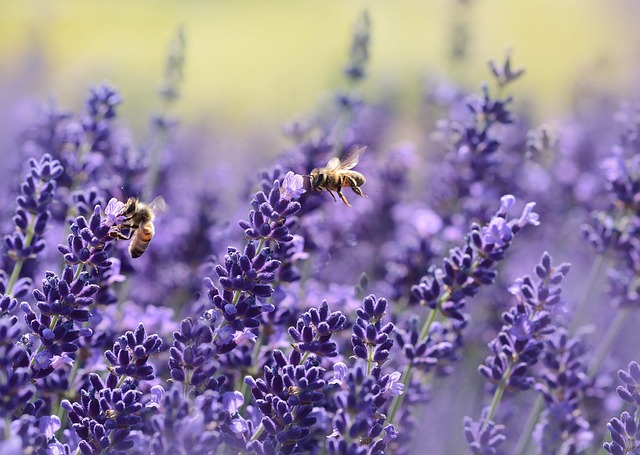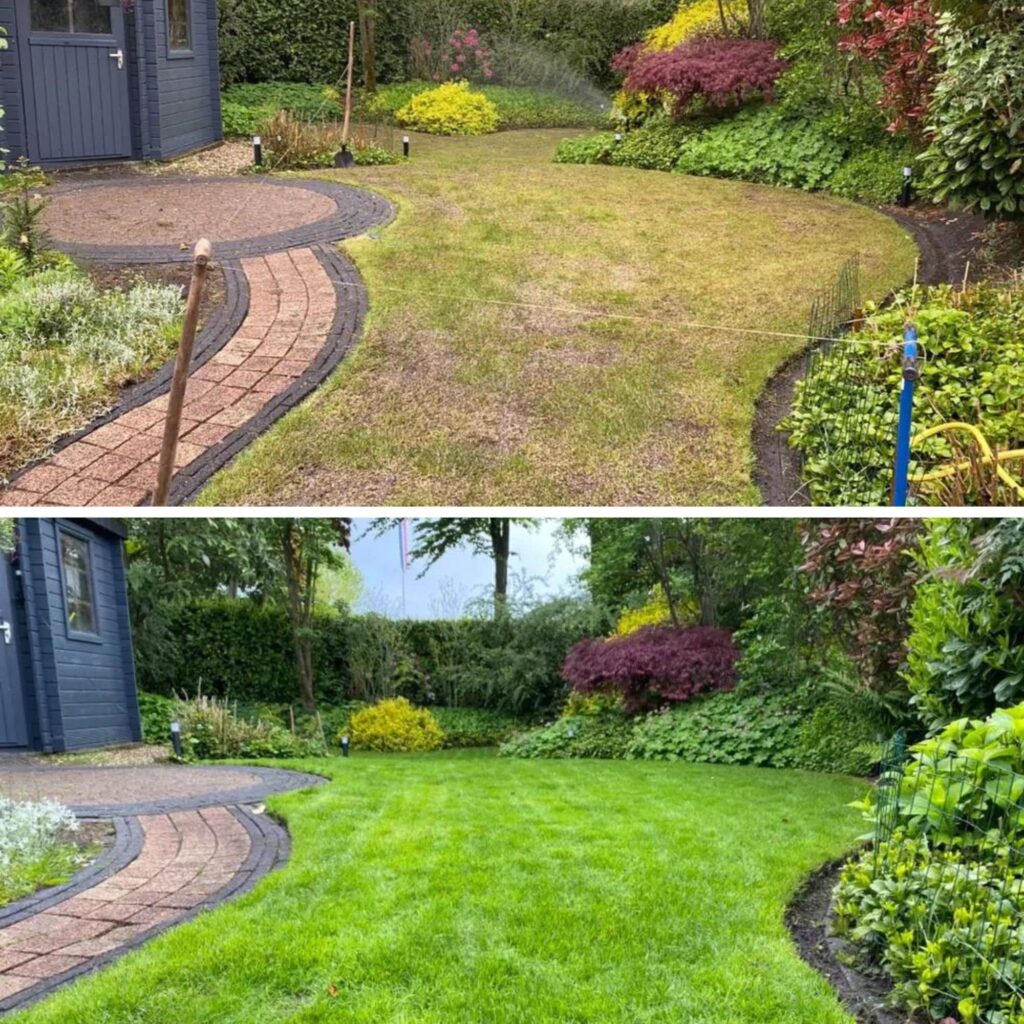Log in or create new account to save this product to your wishlist.

How to Design Your Dream West-Facing Garden
West-facing gardens are shaded in the morning and sunny in the afternoon and evening. And just look at those sunsets! How to make use of this striking garden orientation.
🌱 All important maintenance moments for your lawn during the year. Leave your email and we will send you the lawn calendar for free.
Enter your email
Receive the lawn calendar in the mail
Enjoy a green lawn all year round!

- Order by 2PM = shipped today
- 250.000+ satisfied customers!
- 60 day satisfaction guarantee
A west-facing garden is typically in the shade in the morning and in full sun during the afternoon, offering the best views of the sunset. So, if you’re lucky enough to have a west-facing garden, you’ll be spoiled by the warming afternoon sun and a daily show of striking beauty in the skies.
- What are the features of a west-facing garden?
- How to determine your garden’s orientation
- The hours of sunshine in a west-facing garden
- The pros and cons of a west-facing garden
- The perfect plants for a west-facing garden
- Your soil type
- Does a lawn do well in a west-facing aspect?
- Tips for your terrace in a west-facing garden
- Laying out your west-facing garden
- Mulch and soil improver
- Design your west-facing garden around nature
- FAQs
Lucky you!
But how do you make the most of your west-facing aspect?
This article is all about making optimal use of a west-facing garden.
Ready? Let’s go!
What are the features of a west-facing garden?
A west-facing garden is located on the west side of your home, which plunges your garden into shade during the day.
The features of a west-facing garden are:
- Morning shade vs Afternoon sun — depending on the size and height of your home, your west-facing garden is in shade or partial shade in the morning. However, you’ll get plenty of sunshine in the afternoon. And if the aspect is clear, you’ll enjoy amazing sunsets.
- Plant selection — if you have a west-facing garden, choose plants that prefer afternoon sun and can tolerate morning shade. Read on for a list.
How to determine your garden’s orientation

There are several ways to determine your garden’s orientation:
- Use a compass — stand in the middle of your garden and hold your compass horizontally, pointing the needle to the north. Or use a compass app on your phone.
- The sun’s movement — in the western hemisphere, the sun rises in the east and sets in the west. So shade in the morning and sun in the afternoon means your garden faces west.
- Check your property on an online map, using the compass to establish the orientation.
The hours of sunshine in a west-facing garden

The sunniest of the garden orientations is south-facing, which receives full sun all morning, afternoon, and into the evening. West-facing gets less full sun, obviously.
And while there’s a difference between the hours of sunshine the UK typically receives would be different at the northern tip of Scottland from the south coast of England, a UK garden gets an average of:
| Month | Hours of sunlight |
|---|---|
| January | 8.25 |
| February | 10.04 |
| March | 11.53 |
| April | 13.55 |
| May | 15.40 |
| June | 16.41 |
| July | 16.15 |
| August | 14.42 |
| September | 12.45 |
| October | 10.48 |
| November | 8.57 |
| December | 7.56 |
The pros and cons of a west-facing garden

If you enjoy cool shade in the mornings as you eat your breakfast on the patio and sunny afternoons as you sip a glass of something pleasant after work, then west-facing gardens are your ideal haven.
However, that shade/light profile can restrict which plants will thrive in a west-facing garden. And because the midday to early afternoon sun is the strongest, it can get scorching for your plants.
The perfect plants for a west-facing garden

Here are some plants that prefer a west-facing aspect:
- Roses
- Lavender
- Sunflowers
- Fathen
- Yarrow
- Hibiscus
- Echinacea
- Phlox
- Ornamental Lilies
- Lilies
These plants thrive in the afternoon sun, attracting butterflies, bees, and other beneficial wildlife into your garden. And, of course, they provide bountiful blooms throughout the summer, offering colour and texture for your west-facing outdoor space.
Find out more about how to nurture flowering plants in your garden.
Your soil type

Of course, one of the properties of your garden that many people fail to consider is the soil type.
For example, if your earth is sandy, it will need regular fertilising and frequent watering because sandy soil doesn’t hold moisture well.
On the other hand, clay soil holds onto its nutrients better but is prone to flooding as it doesn’t drain well.
Either way, you can address your soil conditions to create a supportive environment for your plants and lawn. For more information, check out our expert article on how to improve your soil’s quality.
Does a lawn do well in a west-facing aspect?

Short answer: absolutely. West-facing gardens are perfect for grass plants, offering lots of morning shade and afternoon sun.
However, you’ll need the correct type of grass plants to cope with the extremes of full sun and shade.
So, I recommend MOOWY’s Shade and Sun grass seed for great colour, resistance, and full coverage, even by walls, underneath trees, and in weedy, wet regions of the garden.
However, west-facing lawns may require more watering as they’re exposed to the hottest duration of the sunlight, which can dry out your grass plants more quickly. So, bear this in mind.
Tips for your terrace in a west-facing garden

A terrace or decked area sits nicely in a west-facing outdoor space because it maximises the appeal of the afternoon and evening sun.
Here are some tips for your terrace design:
- Sun protection — incorporate parasols, pergolas, and sun sails to create a pleasant environment out of full sun
- Garden furniture — you can get some genuinely comfy outdoor sofas and chairs these days, so choose durable, weather- and sun-proof furniture to help you make the most of those sunny afternoons.
- Plants — fill your terrace space with flower pots and boxes. Taller plants, such as vines, offer excellent dappled shade protection while low-growing plants provide plenty of colour and texture.
- Evening lighting — your west-facing garden will likely remain warm in the evening, even as the sun goes down. But you can extend your evening entertainment with string lights, lanterns, and solar lights that create a cosy atmosphere.
- Flooring — decking can get slippery over the winter, so maintain it by sanding it down every couple of years and treating it with wood sealant/decking paint. This doesn’t stop it from being slippery, but it prevents the build-up of moss and mould, which can be hazardous and slippery. Shaded areas of the deck are more likely to develop moss or mould than sunny spots.
Laying out your west-facing garden
Spend a week or so watching your garden at different times of the day. Can you identify the shadiest areas? Are there areas that get maximum sun? Is there boggy soil in the dark regions?
Here are some tips to help you decide upon your layout:
Choose plants according to the daylight
Shady areas of your garden require specific plants to bring lasting colour and texture. Remember, shaded regions will likely have wetter soil, so add organic matter, such as compost, into the earth to help drainage.
These plants are happy in the shade:
- Coleus
- Pansy
- Lobelia
- Ferns
- Hosta
- Alchemilla
- Heuchera
- Woodruff
- Lily of the Valley
- Forget-Me-Not
- Asian Bleeding Heart
- Rhodendron
- Yew
- Alpine Currant
- Sedge
Find out more about these shade-loving plants in our expert article: Choose the best shade-loving plants for your garden.
Sun-loving plants
It’s usually easier to find plants that thrive in full sun because most plants are relatively tolerant of direct sunlight, although some prefer shade.
The following plants are perfect for sunny areas:
- Lantana
- Salvia
- Petunia
- Coneflower/echinacea
- Daylily
- Russian Sage
- Lavender
- Stonecrop
- Zinia
- Peony
- Canna
- Yarrow
- Bougainvillea
- Marigold
- Blanket flowers
Check out our Ultimate Guide to Summer Flowers.
Mulch and soil improver
Sunny areas are prone to drying out quickly, so add mulch to the soil surface around the base of your plants to help retain its moisture.
And you may need to improve your soil — sandy soil can be too light and quickly drained, while heavy soil is too water-retentive and prone to flooding.
For sandy soil, add nutritious compounds that maintain its structure, such as homemade compost, leaf mould, or horticultural clay.
For heavy soil, mix it with horticultural sand to lighten the texture. And aerate the soil regularly with a hollow tine aerator.
Check out our expert’s guide to improving your garden soil.
Design your west-facing garden around nature
Identify sunny spots for decking areas and terraces, and make the best use of the shaded areas, filling them with plants that thrive in the shade.
And if you’re considering renovating or refreshing your lawn, consider Shade & Sun grass seed for shade-tolerant grass that also thrives in full sun.

- Ideal for shady gardens
- Tolerant of full sun
- Hardy, resistant, and grows quickly
FAQs
West-facing outdoor spaces get around 7.5 hours of sunlight in the depths of winter and up to 16 hours at the height of summer. The west-facing aspect is defined by shade in the morning and sunshine in the afternoon.
A west-facing garden is typically shaded in the morning and in full sun during the afternoon and early evening. And if the aspect is clear, you should see lovely sunsets.
Roses, lavender, sunflowers, fatty chickens, yarrow, hibiscus, sun hat, lilies, phlox plants and decorative lilies are suitable for a garden with a west orientation.
Any questions?
I hope you’ve got all the tips you might need to make the most of a west-facing garden, but if you have any questions, don’t hesitate to ask.
Or check out our encyclopedia of lawn care and gardening in our Help & Advice section.
Thanks for reading. And happy gardening designing!
-
Orchids: A Complete Guide on How to Care for ThemWant to give your orchid the best possible care? Discover essential tips from placement to watering and pruning. Learn everything you need to know!Read more
-
Growing Wisteria Made Simple: From Planting to Perfect BloomsWith blossoms like a purple waterfall, Wisteria sets an almost magical and colourful mood. If you want to grow this beauty in your garden, you’ll need a bit of patience. Don’t worry, it will most definitely pay off.Read more
-
How to Build a DIY Greenhouse: A Practical Guide for Smart SpendersImagine extending your growing season throughout the year, nurturing tender plants regardless of the weather, and creating a personal garden sanctuary. This is precisely what a DIY greenhouse offers you. Let’s learn how to build one.Read more
-
How to Grow Eucalyptus in British GardensWith a little love and care, eucalyptus trees can thrive in English gardens. Since they don’t germinate well without proper help, there are not considered invasive. So, there is no reason not to plant them if you enjoy their looks.Read more
-
Transform Your Garden with All-Year-Round Flowering PlantsDid you know you can enjoy blooming flowers even in January? With the right selection of all year round plants, there’s no need to wait until spring to add some colour to your garden.Read more
-
How to Create a Butterfly Garden: A Simple Guide for British GardensThe UK's butterfly population includes 59 different species. These beautiful winged creatures face a steady decline because of habitat loss, pollution and changing weather patterns. Your garden can become a vital link between nature reserves and natural habitats. Let’s explore how.Read more
-
Volcanic Rock Dust for Your Garden—Application and TipsDid you know that volcanic rock dust is a brilliant organic soil improver? This article explains exactly what it's good for and how to use it properly.Read more
-
How to Use Landscape Fabric ProperlyIf weeds or erosion in your garden are troubling you, landscape fabric might be the solution. We’ll explain how and when to use it properly, just keep on reading.Read more
Leave a comment
Your answer will be displayed on the site and the interested party will be notified by email.
Leave a comment
Have a question or want to share your experience? Leave us a comment.

- Order by 2PM = shipped today
- 250.000+ satisfied customers!
- 60 day satisfaction guarantee

- Order by 2PM = shipped today
- 250.000+ satisfied customers!
- 60 day satisfaction guarantee

🌱 All important maintenance moments for your lawn during the year. Leave your email and we will send you the lawn calendar for free.
Enter your email
Receive the lawn calendar in the mail
Enjoy a green lawn all year round!






















Comments (0)
There are no comments yet. Well then, what are you waiting for to
Be the first to write your comment!inaugurate this pretty page?
Do you have some comments?